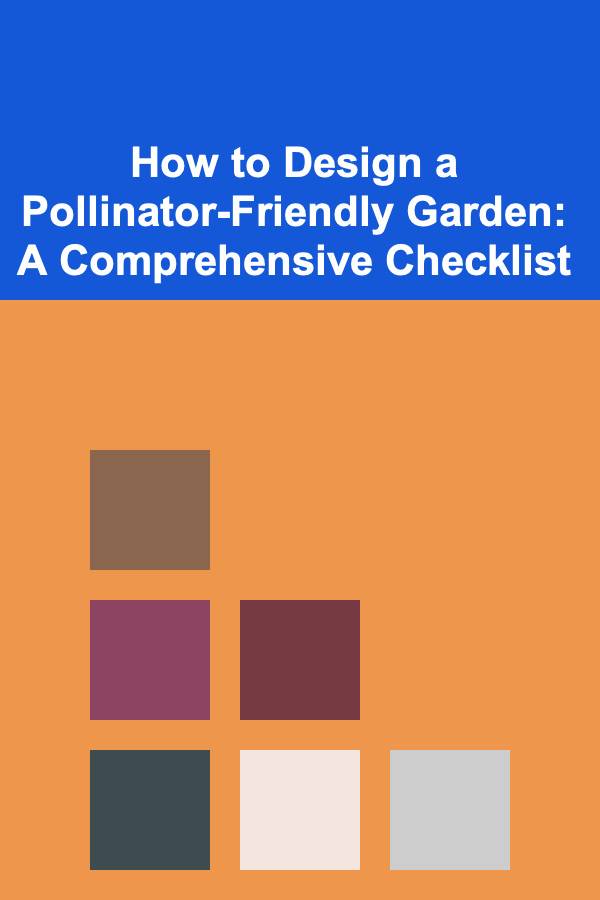
How to Design a Pollinator-Friendly Garden: A Comprehensive Checklist
ebook include PDF & Audio bundle (Micro Guide)
$12.99$7.99
Limited Time Offer! Order within the next:

Designing a pollinator-friendly garden is not only a rewarding experience but also a vital contribution to supporting local ecosystems. Pollinators, including bees, butterflies, birds, and other insects, play a crucial role in the reproduction of many plants, including crops and wildflowers. By creating a garden that provides the food, shelter, and environment needed for pollinators, we can help protect these essential creatures, ensure biodiversity, and support ecological balance.
This checklist provides a detailed guide for designing a pollinator-friendly garden, whether you're a seasoned gardener or a beginner. From choosing the right plants to understanding the best practices for maintenance, each step is crucial for attracting and sustaining pollinators throughout the year.
Understand the Role of Pollinators
Before you start designing your garden, it's important to understand what pollinators are and why they are essential. Pollinators are animals that help plants reproduce by transferring pollen from one flower to another, facilitating fertilization. The most well-known pollinators are bees, but butterflies, hummingbirds, moths, beetles, and even bats also contribute to this vital task.
By supporting pollinators, you're helping:
- Improve biodiversity: Pollinators help create a diverse range of plant species by facilitating cross-pollination.
- Support food production: Many of the foods we rely on, including fruits, vegetables, and nuts, are directly dependent on pollinators.
- Enhance ecosystem resilience: Pollinators contribute to healthier ecosystems by ensuring the reproduction of both wild plants and agricultural crops.
Creating a pollinator-friendly garden is an easy yet impactful way to participate in conserving these invaluable creatures.
Choose the Right Plants
One of the most important factors in attracting pollinators is providing the right types of plants. A pollinator-friendly garden should offer a variety of plants that bloom at different times of the year to provide consistent food sources for pollinators throughout their active seasons. Additionally, plants should have characteristics that are attractive and accessible to pollinators.
Select Native Plants
Native plants are specifically adapted to your region's climate and soil, and they often provide better food and shelter for local pollinators. Native plants also tend to require less maintenance and are more resistant to pests and diseases, making them ideal choices for sustainable gardening.
Some examples of native pollinator-friendly plants include:
- Bee balm (Monarda)
- Purple coneflower (Echinacea purpurea)
- Goldenrod (Solidago)
- Milkweed (Asclepias)
- Wild lupine (Lupinus perennis)
- Black-eyed Susan (Rudbeckia hirta)
Include a Variety of Flower Shapes and Sizes
Different pollinators are attracted to different flower types. For example:
- Bees are attracted to flowers with wide, flat petals and an easy access point for their bodies.
- Hummingbirds prefer tubular flowers with rich, nectar-filled blossoms, often in bright colors like red and orange.
- Butterflies tend to like flowers that offer ample landing space and provide nectar.
By incorporating a variety of flower shapes, you increase the chances of attracting a diverse range of pollinators to your garden.
Opt for Perennial Plants
Perennials come back year after year, providing a consistent food source for pollinators. Unlike annuals, which need to be replanted each season, perennials help create a stable habitat for pollinators in your garden.
Popular perennial plants that attract pollinators include:
- Liatris (Blazing Star)
- Asters
- Lavender
- Salvia
- Catmint (Nepeta)
Ensure a Long Blooming Season
Pollinators need a continuous source of food, so it's essential to plan your garden with plants that bloom at different times of the year. By ensuring that flowers are blooming from early spring to late fall, you can offer pollinators a steady supply of nectar and pollen.
Early Spring Bloomers
In early spring, when the weather begins to warm up, pollinators such as bees are emerging from hibernation and looking for food. Include flowers like:
- Crocus
- Daffodils
- Hellebores
- Snowdrops
Summer Bloomers
During the warmer months, many pollinators are actively working to gather nectar and pollen. Include a variety of plants that bloom during summer, such as:
- Sunflowers
- Zinnias
- Echinacea
- Bee balm
Late Fall Bloomers
As the weather cools down, it's essential to have plants that continue to bloom and provide food for late-season pollinators. Plants like:
- Asters
- Goldenrod
- Sedum
Provide a Water Source
Pollinators need water to survive, and a reliable source can make your garden even more attractive to them. A simple birdbath or shallow water feature can provide the necessary hydration for bees, butterflies, and hummingbirds.
Designing a Water Source
- Shallow containers: Shallow birdbaths or small containers with stones for pollinators to land on will work well.
- Water with a gentle flow: A small fountain or moving water feature can attract bees and other insects, as they prefer water that's not stagnant.
- Freshwater supply: Ensure that the water is clean and changed regularly to avoid the growth of harmful algae or bacteria.
Offer Shelter and Nesting Sites
Providing shelter and safe nesting sites is crucial to supporting pollinators throughout their life cycle. Bees, in particular, need a safe space to build their nests. Other pollinators, such as butterflies and moths, need places to lay eggs and rest.
Provide Bee Nests
- Bee hotels: These are specially designed structures with small hollow tubes where solitary bees can lay their eggs.
- Dead wood: Leaving some fallen branches and dead trees in your garden can provide nesting opportunities for wood-nesting bees.
Support Butterfly Habitats
- Host plants for caterpillars: Many butterflies rely on specific plants to lay their eggs, such as milkweed for monarchs. Providing these plants in your garden can help caterpillars thrive and eventually turn into butterflies.
- Mimic natural habitats: Butterflies need a combination of sunny spots to bask and shady areas to hide from predators. Create these diverse spaces within your garden to provide the best conditions for them.
Reduce Pesticide Use
Pesticides are one of the biggest threats to pollinators. Chemicals intended to kill pests can also harm beneficial insects, including pollinators. Reducing or eliminating pesticide use in your garden is a vital step toward creating a pollinator-friendly space.
Use Natural Alternatives
If you must manage pests in your garden, opt for organic or natural solutions, such as:
- Neem oil
- Insecticidal soap
- Diatomaceous earth
Encourage Beneficial Insects
In addition to pollinators, many insects help control pests naturally. Planting a variety of herbs and flowers can attract beneficial insects such as ladybugs, lacewings, and predatory beetles, which help manage harmful pests.
Create a Diverse Garden Habitat
A diverse garden attracts a variety of pollinators. The more types of plants, flowers, trees, and shrubs you include, the more likely you are to provide a wide range of food sources and shelter options. Don't limit yourself to a few flowers---try incorporating trees, shrubs, and ground covers that offer food and shelter in various layers.
Layering in Your Garden
- Canopy layer: Large trees like oaks and maples that provide shelter for birds and insects.
- Shrub layer: Bushes such as elderberry or sumac that offer berries for birds and shelter for pollinators.
- Herb and flower layer: A mix of flowering perennials, annuals, and herbs like lavender, sage, and thyme.
Avoid Monocultures
While certain plants might be appealing to pollinators, creating large areas with a single species can limit the food variety and make the garden more vulnerable to pests and diseases. A monoculture---where only one type of plant dominates---is not ideal for a pollinator garden.
Diversify Your Plant Choices
Include a mix of plant types, including different flower shapes, sizes, and colors. This diversity ensures that your garden supports a range of pollinators and is more resilient to pests and diseases.
Make the Garden Accessible
Pollinators need to access your plants easily. If your garden is difficult for them to navigate, they may go elsewhere in search of food.
Avoid Barriers
- Walkways and paths: Keep paths clear to make it easy for pollinators to move through your garden.
- Avoid chemicals: As mentioned, chemicals can be harmful to pollinators, making it harder for them to navigate your garden safely.
Maintain the Garden Year-Round
A pollinator-friendly garden is not just about planting the right plants; it's also about maintaining the garden throughout the year. Regular maintenance helps ensure that pollinators continue to thrive in your garden.
Winter Considerations
- Leave seed heads on plants during winter. Birds and other pollinators can use these seeds for food in the colder months.
- Clean up your garden in early spring, but avoid disturbing dead plant material, which can provide homes for overwintering insects.
Regular Monitoring
Check your garden regularly to ensure that it's still attractive to pollinators. Take note of any plants that are particularly popular with bees or butterflies, and consider adding more of those species.
Conclusion
Designing a pollinator-friendly garden is an important step in supporting the health of local ecosystems and contributing to biodiversity. By following this checklist and focusing on plant selection, providing shelter and water, reducing pesticide use, and maintaining a diverse habitat, you can create a garden that offers pollinators the resources they need to thrive. Not only will you be helping to sustain these vital creatures, but you'll also enjoy a beautiful, thriving garden filled with life.
Reading More From Our Other Websites
- [Home Renovating 101] How to Plan a Home Renovation Project Without Breaking the Bank: Budgeting and Cost-Saving Tips
- [Home Maintenance 101] How to Maintain Your Home's Solar Panels
- [Personal Financial Planning 101] How to Navigate Financial Conversations with Your Partner
- [Organization Tip 101] Raised Garden Bed vs. Ground-Level Garden: Which Is Better for Your Yard?
- [Personal Investment 101] How to Analyze Real Estate Markets and Invest Wisely
- [Soap Making Tip 101] Best Ways to Incorporate Charcoal for Detoxifying Soap Bars
- [Home Party Planning 101] How to Host a Friendsgiving Party That Everyone Will Love
- [Sewing Tip 101] Threading the Needle: A Beginner's Guide to Sewing Confidence for Grown-Ups
- [Home Pet Care 101] Common Mistakes New Pet Owners Make
- [Home Rental Property 101] How to Set Up an Online Rental Payment System for Your Tenants

How to Create a Checklist for Planning Your Next Party
Read More
How to Invest in Bonds and Understand Their Risks
Read More
How to Keep Your Bathroom Counter Clutter-Free
Read More
How to Make Money Online as a Print-on-Demand Seller
Read More
Turn Deep Learning into a Sustainable Source of Passive Income
Read More
How to Animate Rod Puppets for Storytelling
Read MoreOther Products

How to Create a Checklist for Planning Your Next Party
Read More
How to Invest in Bonds and Understand Their Risks
Read More
How to Keep Your Bathroom Counter Clutter-Free
Read More
How to Make Money Online as a Print-on-Demand Seller
Read More
Turn Deep Learning into a Sustainable Source of Passive Income
Read More